
|
The Shipbuilding market in 2004 |
The economy and
trade
Freight rates
Orders
Prices
Analysis by
country
-
Asia
-
Europe
-
Russia
-
U.S.A.
Prospects
|
|
For the shipbuilding markets, 2004 can justifiably be
considered as the year that broke all records. This
phenomenal upsurge of newbuilding activity in 2004, has been
characterised by a number of salient factors:
' A flood of new orders in the shipyards. This has
been equalled only by the record volumes across tonnage
types achieved in 2003. During the course of 2004, the world
orderbook jumped from 125 million gt to nearly 165 million
gt, representing more than 3,700 ships. This figure was only
65 million gt in mid 2002. Deliveries are spread out to
year-end 2008, and in some cases the shipyards are committed
through to 2009.
' A strong rise in sale prices. The top prices
achieved for tankers and bulk carriers at the beginning of
the 1990's have been reached again and even exceeded. The
long-standing symbolic barrier of $100 million for VLCCs and
very large containerships has been surpassed; in some cases
by as much as 20 %. Exceptionally high freight rates have
brought on fierce competition between owners. This has been
witnessed in the numerous resales of ships under
construction, and in the second-hand market ships have been
purchased at prices above newbuilding prices. These factors
have conspired to bring about the price hikes have seen in
2004. At the same time, builders have been facing
exceptional cost increases mainly due to more expensive
supplies and a depreciation of the dollar. Shipyards have in
this respect received only the meagre leftovers of the
lucrative financial results being enjoyed in the shipping
sector.
' An increase of global shipbuilding capacity.
Korea has once again consolidated its position as the world
shipbuilding leader with an orderbook of about 62 million gt
compared with 49 million gt in 2003. Japan has reaffirmed
its second-place position with nearly 54 million gt as
opposed to 43 million gt twelve months earlier. China has
continued its inexorable ascent with near to 26 million gt
against 17 million gt at the end of 2003. Against this
increase in orders in the Far East, the Asian shipyards'
saturation has helped to bring about an increase in activity
in the West and East European shipyards. Between year-end
2003 and year-end 2004, West and East European orderbooks
climbed from 6 to nearly 8.5 million gt and 5 million to
nearly 7.5 million gt, respectively. The desperate search
for newbuilding berths with early delivery dates has sent
owners off to other more remote destinations (Vietnam, Iran,
Russia, India, Brazil, Dubai '.. ) whose figures have gone
up from 4 to 7 million gt.
' An adaptation to the new situation. Builders and
owners have been seen to adapt their attitudes facing
this new situation. Builders have become more and more
discriminatory. They have given preferential treatment to
ships, of which the values maximise the turnover of each of
their berths, or standard designs. They have also been seen to give priority
to their faithful clients, and clients who are deemed not
too demanding. This behaviour has been brought on in large
part due to the worrying cost increases on existing
contracts, which have seriously dented shipyards' profit
margins in 2004, despite the rise in newbuilding prices
during the year. Owners, who are reaping the financial
benefits due to a freight market, which has been unequalled
in modern times, are visibly more relaxed and even sometimes
euphoric. Whereas only a short time ago, owners used to
bitterly discuss technical specifications, prices and
payment terms, nowadays they are more pragmatic, accepting
terms and conditions imposed by shipyards, provided that
they allow them to place new orders.
|
|
The economy and trade
In 2004, the world economy made strong gains with an
average GDP growth rate of 5 % per year. This signifies the
largest increase during the past 30 years. In tandem with
world growth, commercial trade has flourished, increasing
almost 9 % compared to a growth of commercial trade of 5 %
in 2003.

This rapid expansion and the increase in the demand of raw material, largely explains the
unprecedented hike in freight rates as well as the large
number and volume of transactions on the second-hand and the
newbuilding markets.

|
|
This rapid expansion and the demand that this has
generated on the raw material market, largely explains the
unprecedented hike in freight rates as well as the large
number and volume of transactions on the second-hand and the
newbuilding markets.
Freight rates
Dry bulk freight rates continued their irresistible
ascent and achieved historic levels. This frenzy has been
fed by the enormous demand for raw materials generated by
China, which has become the world's main importer of most
raw materials in a few years. This drastic rise in rates has
brought about a fear of overheating throughout the year. The
declarations of the Prime Minister of China at the end of
April certainly set the tune for the serious correction that
occurred during the spring. This correction was however
short-lived. By the beginning of summer, rates had started
to climb again. Despite very high volatility (the Baltic Dry
Index swung between 2,600 and 6,200 points), these rates,
which had already doubled on average between 2002 and 2003,
doubled again between 2003 and 2004.
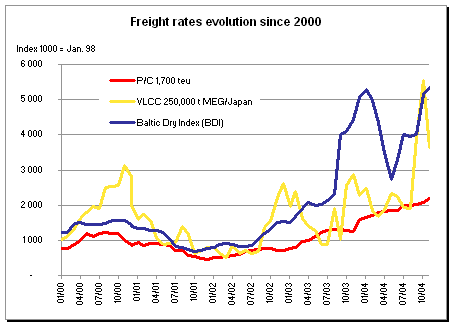
In 2004, containership rates were bolstered by the growth
in commercial trade and Chinese exports. The American
commercial deficit has reached historically high levels at
nearly $600 billion. By and large the containership rates
manifested less volatility compared to the dry bulk or
liquid markets as it is characterised by line operators
employing owned or long-termed chartered ships on their
routes. Containership rates, which doubled on average
between 2002 and 2003, have tripled between 2002 and 2004.
For the first time the price of crude oil broke the
$55/bbl barrier in 2004, and the oil market has remained
extremely nervous throughout the year. Freight rates for
tankers doubled on average between 2003 and 2004.
Despite relatively high volatility, freight rates thus
have achieved record levels in 2004, allowing owners to get
substantial investment leverage for ordering new ships. It
was by no means obvious at the end of 2003 that owners would
be able to order in 2004 as many ships as the previous year.
Yet they did so, and at higher prices and for later
deliveries.
|
|
Orders 
|
|
Bulk carriers
With nearly 37 million dwt ordered compared
with 33 million in 2003, orders for bulk carriers and in
particular for Capesizes were numerous in 2004.
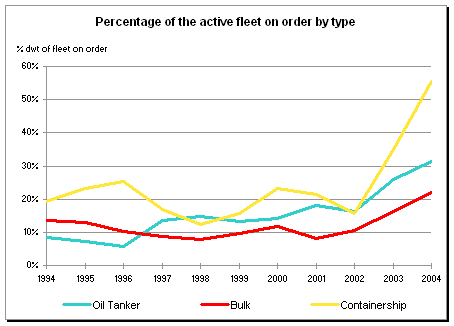
The orderbook has increased and gone from 53.1
million dwt at year-end 2003 to 71.6 million dwt year-end
2004. The fleet on order at the end of 2004 represented
nearly 22% of the existing fleet, as against 17% in 2003.
The uncertainties surrounding the future necessity for
double-hulled vessels was settled in May 2004 with a
decision to keep the status quo.
Owners faced several problems in finding berth
space to order their bulk carriers, ships often judged to be
too simple by builders. Korean shipyards prefer to build
ships with better returns and bulk carriers in Korea only
represent 5 % of the shipbuilding market as compared to 25 %
in 2000. Apart from certain shipyards that today are making
it their speciality (like Shanghai Waigaoqiao Shipyards
(SWS) and Bohai for Capesizes, Jiangnan and Hudong-Zhonghua
for Panamaxes), Chinese shipyards are by and large moving to
other types of ships. This leaves predictably Japanese
builders with the lion's share of this sector, with nearly
65 % but they also give priority to domestic owners and are
saturated.
Owners and operators are looking for economies
of scale and a number of 200,000 dwt bulk carriers as well
as 230,000 and 300,000 dwt ore carriers have been ordered.
The latest very large ore carriers were delivered by Hyundai
Heavy Industries in 1992 and Daewoo in 1997.
In sum, demand for bulk carriers remains strong
and has not as been totally satisfied yet.
Containerships
With close to 26 million dwt on order, demand
for containerships has been as sustained as in 2003.
The orderbook has grown at a consistent pace,
going from 35.5 million dwt at the end of 2003 to 54.3
million dwt in 2004. The fleet under construction at
year-end 2004 represents a figure of 53 % of the existing
fleet, as against 35 % in 2003 (only cellular ships), which
gives rise to some concerns.
Korean shipyards, which hold nearly 65 % of the
market were unable or did not want to satisfy the totality
of this buoyant demand. They have concentrated almost
exclusively on very large containerships, leaving
opportunities for Chinese, Taiwanese, Singaporean, German
and Polish shipyards to fill the void.
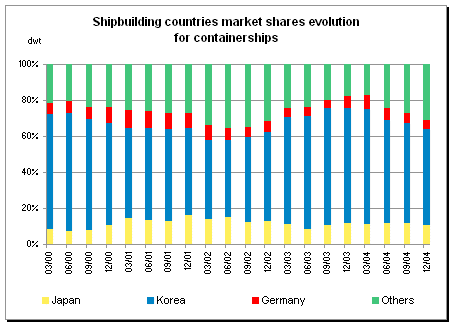
In a way, containerships have set the pace for
the newbuilding market in pushing prices higher. It is
indeed the sector which has seen the strongest demand.
Amongst the main three segments that form the core of
newbuildings, this is the one that offers the highest prices
to the builders, other factors being equal. The added value
to the shipyards is also higher as these ships require less
steel, less external procurement, are often ordered in
series and can be easily adapted or modified.
As was the case in 2003, a number of
over-Panamax containerships were ordered in 2004. With close
to 50 units over 7,500 teu in service, 170 units were on
order by the end of 2004. New size records were achieved
with the order of container carriers of 9,300 teu for the
account of AP Moller, whilst CMA-CGM and Hyundai Heavy
Industries agreed to extend the capacity of ships previously
ordered from 8,300 teu to 9,300 teu. The 10,000 teu barrier
will shortly be broken, probably bringing about a new wave
of orders, motivated by a race for size between operators.
The coming about of a new generation of containerships above
10,000 teu will nonetheless require to adapt port handling
facilities.
In the meantime, demand for smaller container
carriers (1,100, 1,800, 2,700, 3,500, and 4,300 teu), which
are usually employed as feeders for the large mother
vessels, has also been very healthy. This trend can be
expected to continue. Given that the ratio of the fleet on
order versus the existing fleet is particularly high and
that the predictable growth in teu terms is above
international trade progression, the number of new orders
might logically slow down in the coming months.
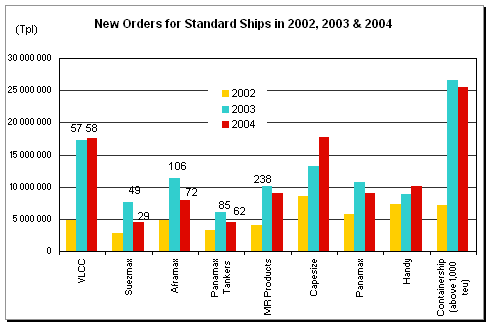
Tankers
With some 44 million dwt ordered, demand for tankers has
remained strong, although lower than that of 2003 with 52
million dwt.
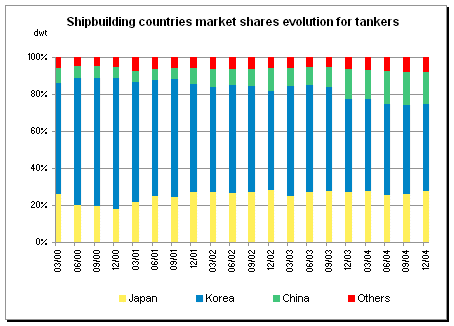
The orderbook has nonetheless increased and has gone from
83.5 million dwt at year-end 2003 to 102.3 million dwt at
year-end 2004. The fleet on order at the end of 2004
represented some 31 % of the existing fleet as compared to
26 % a year earlier.
How does one explain this relatively-speaking smaller
demand this year, especially in comparison to the
progression of containerships and bulk carriers? To
understand this, it is important to recognise that the
renewal of the tanker fleet, started earlier, following the
oil pollution disasters of the 'Erika' in 1999 and the
'Prestige' in 2002. The average volume ordered each year
since 1999 has in fact been 30 million dwt for tankers as
against 22 million dwt for bulk carriers and 14 million dwt
for containerships. In addition, the competition with
containerships in the shipyards has also played its part.
Demand for ice-strengthened tankers has remained
sustained despite a mild winter, essentially responding to
the development of loading of crude or refined products out
of the Gulf of Finland, the White Sea and from the Sakhalin
islands, where Russia and the Baltic states are in the
process of building new ports and expanding their export
capacities. Thus there are 72 MR product carriers, 25
Panamaxes, 41 Aframaxes, and 17 Suezmaxes which are
ice-classed out of respectively 407, 161, 174 and 89 ships
on order.
|
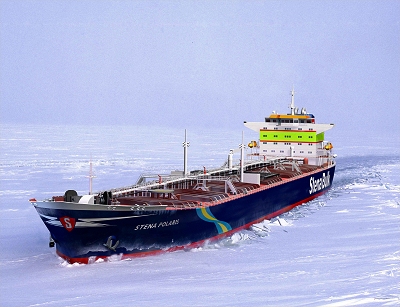
|
Stena Polaris
75,000 dwt, ice class 1A Panamax product tanker,
ordered at Split by Concordia Maritime for
delivery 2006 and long-term chartered to Fortum
Oil
|
|
In addition, traffic is considerably increasing in some
tight waters and it is very likely that the strong growth in
Russian exports out of the Baltic or the Black Sea will
result in the enforcement of new regulations and security
measures from the bordering countries to protect their
coastlines. There is regrettably one incident a month in the
Baltic. Some oil companies and European owners, who want to
improve the security of their ships, have jumped the gun and
ordered ships with double propulsion.
Specialised tonnage
New orders for specialised tonnage have also considerably
increased this year with the exception of Ro-ro's, and
reefer ships. The number of specialised ships remains,
however, weak compared to standard ones. Few sectors have
remained inactive, which is a sign of the vitality of the
shipping market in 2004.
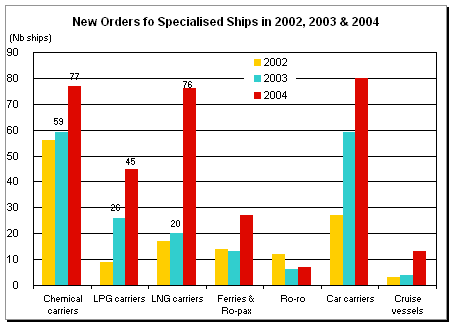
Stainless steel chemical carriers
The number of stainless steel chemical carriers ordered
has gone from 59 in 2003 to 77 in 2004. The orderbook is
growing and has increased from 1.6 million dwt year-end 2003
to 2.1 million dwt year-end 2004. The fleet under
construction at the end of 2004 represented some 16.5 % of
the existing fleet, against 13.8 % a year earlier. Most of
these ships have been ordered at Japanese shipyards. The
demand has not even been entirely met, given that the price
of stainless steel has suddenly become much more expensive
and that yards also suffered from supply disruption.
LNG carriers
During the course of the year the number of LNG carriers
ordered nearly quadrupled, going from 20 to 76. The
orderbook has gone from 63 ships at the end of 2003 to 116
ships, making a total capacity of 17.1 million cbm, by the
end of 2004. The fleet under construction represents about
80 % of the existing fleet compared to 48 % a year earlier.
Many ships have been contracted without long-term
employment.
This market, which has been so far very conservative, is
quickly changing. The maximum size of ships, which was in
the past ranging from 125,000 to 130,000 cbm, has
progressively moved up to 140,000 cbm and then 150,000 cbm.
In order to meet the requirements of the gigantic Qatari LNG
export project, a series of LNG carriers of 210,000 cbm has
been ordered in Korea. In addition, diesel-electric
propulsion seems to be progressively more sought after.
The majority of the orders was placed in Korea and Japan
in 2004. The European shipyards who invented this
sophisticated type of transport and banked on a strong
future demand, are practically absent from this market. This
year, Hudong-Zhonghua of Shanghai joined the 'club' of LNG
carrier builder with the order in August 2004 for two ships
of 147,000 cbm.
LPG carriers
The number of new orders for LPG carriers has practically
doubled, going from 26 in 2003 to 45 in 2004. The orderbook
has also risen from 1,6 million cbm at year-end 2003 to 2,6
million cbm at year-end 2004.
The majority of the orders of small LPG carriers has been
placed at Japanese yards, whereas those of bigger sizes have
been placed in Korea, with the exception of some large units
contracted with Mitsubishi Heavy Industries and Kasawaki
Heavy Industries in Japan and with Gdynia in Poland.
Ferries and Ro-pax
The number of Ferries and Ro-paxes on orders went from 13
to 27. The total orderbook increased from 32 ships at
year-end 2003 to 46 ships year-end 2004.
With the exception of a Ferry ordered in Japan by a
domestic owner and an option to declare by Norfolk Lines for
a newbuilding at Samsung in Korea, the 27 Ferries and
Ro-paxes ordered in 2004 have been placed at European
shipyards, with the Italians being awarded nearly half of
this total. This situation is largely due to the
concentration of Asian builders on more standard ships.
Ro-ro's
Only a few Ro-ro's were ordered in 2004. The few European
shipyards which possess a real expertise in this type of
ship are quoting prices in euros, which are often
prohibitive to charterers, given the freight levels in this
sector. Only a handful of projects actually materialised.
Car-carriers
The number of Car-carriers ordered went from 59 in 2003
to 80 in 2004. The orderbook has increased and reached a
capacity of nearly 800,000 vehicles at year-end 2004, a
considerable increase from 526,000 vehicles at year-end
2003.
New orders have almost exclusively been placed for large
PCTC (Pure Car Truck Carriers) with a capacity of 4,300 up
to nearly 7,000 cars. These orders have been contracted with
yards in Japan and Korea, and also in Croatia and Italy.
This sustained demand is a response to the growth of the
world automotive industry. The outsourcing of production and
the development of new markets, as in China, have helped
increasing the demand for new vehicles shipments. The latest
forecasts indicate an annual traffic of about 10 million
vehicles by 2008 as compared to 8.7 million in 2004.
New requirements could soon come about for intermediate
size ships, around 2,000 to 3,000 cars, to be used as
feeders for large carriers or for regional trades in the
intra-European or intra-Asian markets.
Cruiseships
2004 signalled a comeback of confidence by cruiseship
operators of with 13 new orders, all signed up with the four
leading European builders who are specialised in this
sector. It has been the best year since 2000. (see our
article on the cruise market.)
|
|
Prices
Newbuilding prices expressed in dollars have quickly
progressed in 2004. The increase for all tonnage-types was
on average 40 %. By contrast the figure was roughly 20 % in
2003. This figure appeared to be a relatively modest rise
given the strong increase in the volume of new orders over
the year (110 million dwt in 2003 as against 50 million in
2002).
The volume of orders in 2004 remained at the same high
level as in 2003 (more than 100 million dwt). Nevertheless
the situation has been different in 2004 as the production
capacities of builders, whose orderbooks in 2004 were spread
out over three to four years as against roughly two in 2002,
became saturated. This factor militated to push up prices to
levels not seen since before the Asian crisis of 1997/1998.
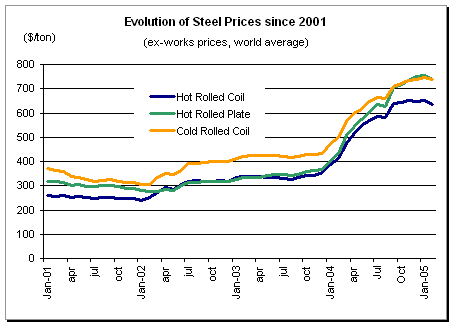
We have seen cascade effects on prices starting from the
newbuilding market to have then an impact on newbuilding
resales and finally on second-hand tonnage. The demand for
tonnage at any cost has pushed up the prices of ships with
prompt delivery dates, as well as the prices of recent
units, to levels above the price being asked by builders for
far later deliveries. The latter have been able to use these
new benchmarks to increase their own prices.
Swift and significant fluctuations in prices help foster
speculation. The behaviour of owners and builders alike, has
changed over the course of 2004. One saw a much greater
reactivity on the part of builders, who have become more
alert to the outside world thanks to the availability of
instantaneous information. They have thus apprehended news
of the latest deals concluded more rapidly.
However, for the moment builders are not getting any
benefits from this situation. They had to face unprecedented
costs increases, as the raw material market took off in
2004. Steel prices doubled and went from $ 300/t to more
than $ 600/t; stainless steel and non-ferrous metal prices
have tripled. This rising cost movement has affected not
only steel plates and profiles, but also pipes, cables,
bulkheads, machinery, pumps, heat exchangers and so forth.
It should be remembered, for reference, that the main engine
onboard a 8,500 teu containership weighs 2,400 tons.
Finally, in addition to all this, energy also became more
expensive.
Could the shipyards have protected themselves against
such increases? Shipyards traditionally ordered their
materials and spare parts, with suppliers and equipment
makers, soon after having signed the newbuilding contracts in
order to fix their costs. This was at the time when ships
could still be expected to be delivered within two years'
time. But the expansion of orderbooks, entailing procurement
exposures much further into the future, no longer allows for
this. As to steel, it is usually payable by the builder the
day of its delivery to the shipyard, which means about
twelve months before the delivery of the ship, given
effective building delays which have become shorter. In
other words, the yard has to pay for its steel requirements
nearly two years after contract has been signed.
Worst still, shipyards have had to face delays in
supplies whilst they have nevertheless had to honour firm
commitments with their clients. Steel shortages came to
public attention when Nissan, the car maker, announced at
the end of November 2004 that they had to halt production
for at least a week. Korean authorities decided during the
year to postpone all exports of steel. Other sectors were
also hit. It was already by the end of 2004 becoming
virtually impossible to find slow speed diesel engines for
delivery in 2007 due to a disruption in the supplies of
essential parts.
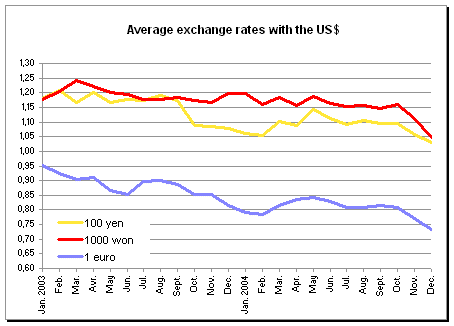
The dollar's unrepentant decline has been another thorn
in the pillow of shipyards. Exchanges rates at the beginning
of 2004 were about 1,200 South Korean won and 106 Japanese
yen for one dollar. By year-end the won stood at 1,050 and
the yen at 103 to the dollar. This trend has as yet shown no
signs of weakness. Despite a fixed exchange between the yuan
and the dollar, Chinese builders have had to buy a large
quantity of equipment overseas (from Europe, Japan, and
Korea) and have thereby suffered from a similar exchange
rate pressures for their supplies. During 2002 in a
difficult market, some builders had accepted delayed payment
terms and now face significant currency losses as a
consequence.
Prices for specialised tonnage have also risen, given the
increases in raw materials costs and a more sustained demand
compared to 2003. But these increases were less significant,
as competition between shipyards remained strong. As an
example, the number of LNG carriers builders is basically
the same as for VLCCs or Capesizes. Thus the price of LNG
ships of 145,000 to 150,000 cbm remained at the very low
levels achieved in 1999, in the region of $155 million,
until mid 2004, when it gradually increased to reach $185
million at the end of the year.
The unprecedented demand, the difficulties shipyards face
in executing current contracts, the numerous doubts
as to the price of materials and equipment, the continued
uncertainty of exchange rates and the recurrent difficulties
in obtaining supplies without too many delays,
should continue to push newbuilding prices higher in 2005.
As a saving grace, we can probably expect a steadier
evolution than we saw in 2004.
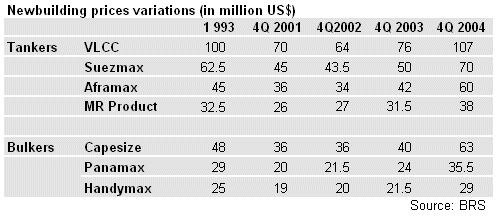
|
|
Analysis by country |
Shipping and Shipbuilding Markets in 2004
I N D E X
|